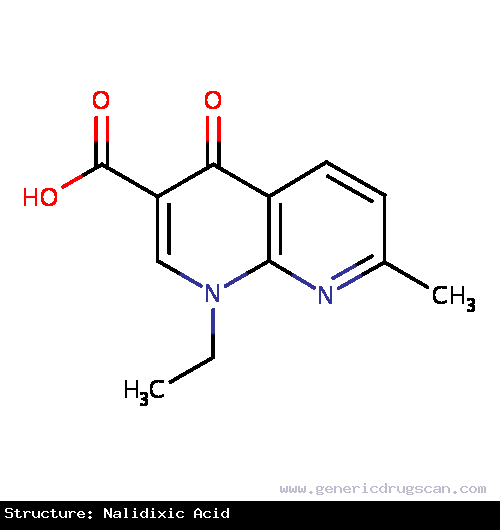Nalidixic Acid Drug: Indication, Dosage, Precaution, Side Effect , Storage, Category Type and corresponding Brands - www.genericdrugscan.com
Nalidixic Acid
Drug Status in Canada : ApprovedIndication : Why is this medication prescribed?
Uncomplicated urinary tract infections. Intestinal infections produced by Salmonella, Shigella, E coli and Proteus.Contraindication: What are the special precautions to be followed?
Under following conditions, use of this medication is inadvisable. Its use should be withhold as it would cause harm to the patientHypersensitivity. Pregnancy and lactation. History of convulsive disorders or porphyria. Infants below three months. Severe renal impairment.
Other Precaution to be observed while taking this medication
Hepatic or moderate renal impairment, severe cerebral arteriosclerosis, G6PD deficiency. Elderly. Epilepsy.What are possible side effects of this medication ?
Drowsiness, weakness, headache, dizziness and vertigo. Decrease in visual activity and double vision, skin rashes, blood dyscrasias, convulsions, photosensitivity, intracranial hypertension. Nausea, vomiting, intracranical HTN in infants and young, metabolic acidosis, peripheral neuropathies, cholestatic jaundice, thrombocytopenia, leucopenia, anaphylactoid reactions. Auto-immune haemolytic anaemia (particularly in elderly patients).Drug Category/Class
- Topoisomerase II Inhibitors
- Anti-Bacterial Agents
- Quinolone Antibacterials
- Antibacterials for Systemic Use
- Antiinfectives for Systemic Use
- Quinolone and Quinoxaline Antibacterials
- Other quinolones
| Prescribed | For the treatment of urinary tract infections caused by susceptible gram-negative microorganisms, including the majority of E. Coli, Ente... |
| Weight : | 232.2353 |
| Structure | Nalidixic Acid |
 | |
| Formula | C12H12N2O3 |
Nalidixic Acid has 20 Brands listed
Search Generic Drugs alphabetically
